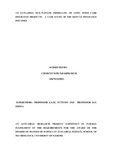| dc.description.abstract | This project illustrates how the mathematics of Markov Stochastic Processes can be used, through the framework of multiple state models, in the actuarial modeling of certain types of Long Term Insurance. Such situations arise when benefits are payable upon a change in the status of the insured or while the insured maintains a given status. Examples include long term medical care insurance, life insurance, annuities, pensions, and disability income insurance.
This markov stochastic processes considered both the time-continuous and time-discrete cases, with constant forces of transition being assumed. However, the project focused on calculations of expected present values of payment streams, and in particular, on calculations of net single and annual premiums of long term medical care stand lone and LTC rider benefits insurance products for the National Hospital Insurance Fund from which the entire data for the four state markov model were derived.
This project is structured as follows: chapter one describes the introduction and background of the use of markov stochastic processes in modeling insurance products, statement of the problem, the research objectives, significance and rationale/justification of the study. Chapter two describes the two state, three state, and four state markov models and processes using Chapman-Kolmogorov equations, Kolmogorov forward differential equations and theoretical and empirical literature reviewed based on similar studies by other actuarial scientists on multi state LTC pricing and reserving models. Chapter three describes the methodology with particular emphasis on the four state markov model, the estimation of the maximum likelihood estimates, parametric graduation of transition rates and probabilities, the calculations of premiums using the equivalence principle, and reserves calculations using Thiele’s differential equations. Chapter four outlines the applications of the four-state multiple state markov model comprising healthy, outpatient and in patient sicknesses and death states within a continuous time-discrete state stochastic process framework with the actuarial pricing and reserving calculations of streams of benefit payments for the National Hospital Insurance Fund of Kenya. Finally, chapter five outlines the summary of research findings, conclusions, and recommendations based on the study findings and discusses opportunities for further research. | en |

